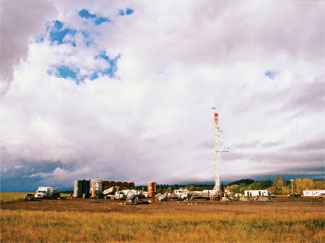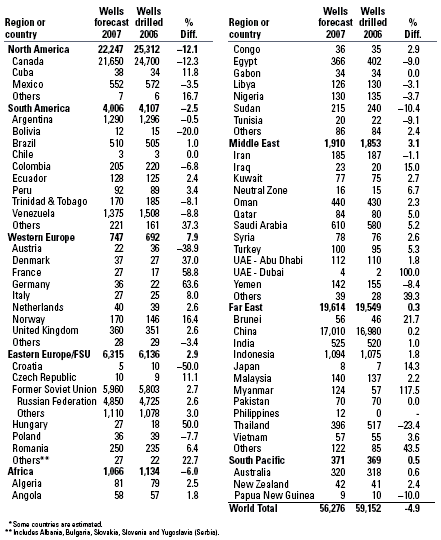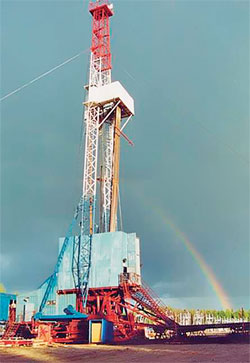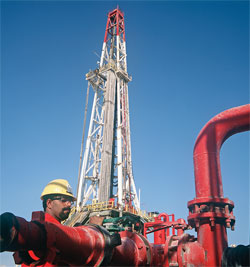OUTLOOK 2007: WORLDWIDE DRILLING
Drilling outside the US hits a plateau
A very mixed bag of data exists from countries outside the US. Some regions are doing very well, and some others are going to have a rougher time this year. And for all the activity and all the technical progress made over the last couple of decades, some of the issues that were problems in the US 30 years ago are still problems today.
Parts of US President George W. Bush’s State-of-the-Union speech last month sounded very much like the original energy outline of former President Gerald Ford, when he took office in 1974. Bush’s call for reducing gasoline usage, cutting US reliance on Middle Eastern oil and stepping up domestic oil production could very well be mistaken for the original US agenda of the 1970s.
Some of the old, familiar trends of the mid-1970s have resurfaced. One of these is the influence of OPEC. After gaining the upper hand in the 1970s, OPEC lost much of its power after oil prices fell in 1982 and 1986. But now, the cartel is experiencing a resurgence. Just recently, Angola, one of Africa’s newest large producers, joined OPEC as a first-time member. And there is word that Ecuador, which left OPEC back in 1992, is considering applying for re-admission to the cartel. Speaking of South America, some of those countries are seeing a whole new wave of nationalism that first gripped the continent in the mid-1970s. History has shown that it was counterproductive and eventually hurt those countries’ upstream industries. Nonetheless, a new crop of leftist presidents thinks that they can clean up on high oil prices by re-nationalizing their respective industries.
Given high oil and gas prices, continued strength in global demand, and political instability in various regions, worldwide drilling will remain at a relatively high level. However, there are some pockets of trouble on the horizon. Accordingly, our forecast calls for wells drilled outside the US to actually fall about 5%, to 56,276. However, if Canada is left out of the equation, then the world outside the US is up less than 1%.
In the offshore sector, in spite of some of the aforementioned factors, drilling will remain quite healthy. In fact, some regions’ offshore sectors will be much better than their land-based activity. Overall, the forecast is for a 1% gain to more than 3,600 wells. The best gains will be in the Eastern Hemisphere, particularly Africa, Europe and the Middle East.
 |
Canadian drilling comprises 38% of activity outside the US. If the decline in that country is left out of the total, the rest of the world will actually be up 0.5%.
|
|
NORTH AMERICA
Despite a large reduction in natural gas prices and some minor softening of oil prices, the Canadian industry set more records in 2006, including new records for drilling and land sales. There were an estimated 24,700 wells drilled last year. Overall, the E&P sector showed growth, but gas-weighted producers and income trusts dragged the broader index down. Speaking of trusts, the ruling Conservative party said it will tax distributions made by Canadian income trusts. Observers predict the new rules will lead some firms to abandon M&A and/or conversion plans, and lead to a resurgence of mid-sized E&P companies.
Not surprisingly, spending should fall in 2007. The Canadian Association of Petroleum Producers predicts that E&P spending will decline 9%, to C$40 billion. However, oil sands spending is growing. Slumping gas prices have shifted spending in favor of oil. About 45% of firms surveyed by Citigroup said that they would shift their drilling toward oil. Given the uncertain climate, the record trend should end in 2007, and levels may fall substantially. Our forecast is for a 12.3% drop to 21,650 wells.
Mexico. Drilling activity softened during 2006, a trend that will continue in 2007. State firm Pemex said that output from giant Cantarell field offshore may decline at an average 14%/year between 2007 and 2015. However, the firm said later that Cantarell’s output dropped 500,000 bopd just during 2006. The company needs to invest $18 billion to $20 billion per year in E&P to shore up output, but it only invested $14 million in 2006 and plans to invest $16 billion this year.
Pemex will invest $276 million in two new gas processing plants to handle output from the Burgos fields of northeastern Mexico. The first should begin operating in June 2008 and the other in October 2008. Each will process up to 200 MMcfgd. Increased Burgos output helped Pemex to raise its gas output to a record level in 2006. The firm produces about 5.6 Bcfgd, including 1.35 Bcfgd from Burgos.
Others. In Cuba, a 12% gain to 38 wells will reflect increases in both exploration and development drilling. The Ministry of Basic Industry said that 10 wells this year will be exploratory. All activity will be onshore. Some additional development drilling will occur around Belize’s first oil discovery. Guatemala will see some infill work.
SOUTH AMERICA
A growing wave of nationalism jeopardizes South American activity. Drilling was up 13% last year, but the 2007 outlook calls for a 3.1% decline. Many of the larger countries will see less activity this year, although the bright spots will be Brazil, Ecuador and Peru.
Argentina. Drilling will be nearly flat at 1,290 wells, after a slight gain last year. Independent operators report some mild successes, while larger operators concentrate on new developments and some production expansions at older fields. Considering what is happening in other nearby countries, Argentina may be the safest haven for operators looking to do work in South America.
Venezuela. The oil price slide may catch up to President Hugo Chavez and state firm PDVSA. Supposedly, the “red line” point at which Venezuela begins to cut back spending is $45/bbl, and that price level has not been all that far away. Furthermore, his plan to nationalize the oil sector, and allow private firms to hold only minority shares in fields, is bound to make some companies head for the exits. Drilling was up about 18% last year, but a drop of 9% is expected for 2007.
Brazil. Wells drilled rose 9.5% last year. For 2007, a further small increase to 510 wells is predicted, including another 182 wells offshore. Brazil had two notable discoveries last year. Petrobras suspended 4-ESS-164A, a well that may be regarded as its best discovery of 2006. The firm reports that it found 280 million boe of 38°API oil. In addition, the Petrobras 1-RJS-628A well was an oil and gas discovery that tested 4,900 bpd of 30°API crude and 5.3 MMcfgd.
Colombia. Activity last year was up 16% at 220 wells. For 2007, drilling will be off about 7%. Colombia’s aggressive promotion of its E&P sector has attracted some nimble independent operators. One of these, Canada’s Pacific Stratus Ventures, plans early production of its La Creciente 1 well as a gas discovery in the Lower Magdalena basin. Officials hope to see similar results from additional new operators.
Trinidad. After roughly doubling last year, Trinidad’s drilling is expected to ease off about 8%. Offshore activity is predicted to remain level at between 40 and 45 wells. Gas development by foreign operators remains sizeable, spread among several projects. State firm Petrotrin accounts for about one-fourth to one-third of all drilling.
Others. In Suriname, state company Staatsolie expects to drill 200 wells, up 26% from 159 last year. Barbados said it will resume drilling this year with 12 wells. A return to drilling in the Falkland Islands last year was postponed to this year, and three tests are predicted. Guyana will boost activity from two wells to five wells, while an offshore wildcat is slated for French Guiana.
| Forecast of 2007 drilling outside the US |
 |
|
WESTERN EUROPE
The outlook continues to look promising in Western Europe. Activity was up last year, and our forecast is for nearly 8% growth in 2007. Increases are expected in nearly every country, with many in double digits. The majority of this year’s increase will be for offshore activity, particularly in Norway, Denmark and the UK.
United Kingdom. In the UK, operators and service companies, alike, had one of their best and busiest years. The UK Offshore Operators Association remains bullish on activity, although there are concerns about manpower and slowing down the rate of North Sea output decline. Also in the North Sea, some operators are benefitting from a tax change made late last year.
The Labour Party administration has agreed to exempt those operators that re-explore old oil and gas fields from the Petroleum Revenue Tax. Officials hope this measure will result in more production. We saw growth in exploration and appraisal drilling during 2005, and that was followed by growth in development drilling in 2006. This year, an increase in both categories is expected. So, overall, there should be at least 360 wells.
Norway. Operators are gearing up to improve recovery rates while also developing new fields. Exploration activity last year was up from 2005’s level, and a continuation of this trend is expected this year. In fact, some analysts expect a record level of exploration during 2007. As shown by the results of the 19th Licensing Round last March, a greater proportion of smaller and medium-sized operators is at work in Norwegian waters, similar to the change that occurred in the Gulf of Mexico as the geology matured. So, the picture looks very good for Norway, with a 16% increase predicted.
EASTERN EUROPE/FSU
High oil and gas prices boosted drilling in the Former Soviet Union, where activity rose roughly 20%. This year a less-ambitous growth rate of 2.7% is predicted. Drilling will expand at a slightly faster rate in the FSU republics outside of Russia. Some small growth in the Eastern European nations outside the FSU is also expected.
Russia. Operators in Russia drilled 27% more wells last year. Among operators posting growth in development drilling were Lukoil, Rosneft, Surgutneftegaz, Gazprom and TNK-BP. Exploration drilling, however, is still a problem, as only four firms had increases. However, BP/Rosneft did hit its third discovery in three wildcats on the Sakhalin 5 concession. Reserves are estimated at 110 million bbl of oil. The 2007 drilling outlook, overall, remains strong, with another incremental gain expected.
 |
Russian drilling jumped 27% higher last year. That country will remain at a high level this year, with another, smaller percentage gain expected. (Photo courtesy of Lukoil.)
|
|
Other FSU countries. In the rest of the FSU, Kazakhstan will drill roughly 60% of the wells, followed by Azerbaijan, Turkmenistan and the Ukraine. In Kazakhstan, Petrom’s Rovnaya South 1 tested 6.9 MMcfgd and 440 bcpd in the Turgay basin. Also, TengizChevroil’s Ansagan 1X established a 135-m oil column in a low-permeability reservoir. Over in Uzbekistan, state firm Uzbekneftegas’ Yumay 1 wildcat proved to be a modest oil discovery, flowing 264 bopd.
Countries outside the FSU. In the smaller countries of Eastern Europe, the outlook for improvement is mixed. New prospect quality has been mediocre, but some success has been achieved in EOR projects.
AFRICA
The continent is cooling off slightly, although work will still be at a high level, above 1,000 wells. Furthermore, offshore work remains very solid, and a 12% gain to 337 wells is forecast.
Egypt. Just over half of Africa’s decline is in Egypt, where onshore work will be down about 25%, but offshore drilling will nearly double. Just over 75% of onshore activity was oil completions, while successful offshore wells were divided between oil and gas. Egyptian General Petroleum Corp. expects an even split between exploration and development wells offshore this year. About one-quarter of onshore wells will be exploratory.
Libya. The re-opening to US firms and greater amounts of investment are bolstering both production and exploration. In the latter category, Woodside Petroleum hit a gas discovery in the C1-NC210 well, in the Murzuq basin, 620 mi south of Tripoli. It tested 5.7 MMcfgd on a 72/64-in. choke from one reservoir and 5.8 MMcfgd on a 72/64-in. choke from a second reservoir. Canada’s Verenex Energy at press time was testing a potential oil discovery in its A1-47/02 well. In addition, National Oil Company last October reported two oil finds by different operators. In one case, Zueitina Oil confirmed an oil find 42 km north of Zella oil field by evaluating and re-testing the C1-NC74A well. In the other well, RWE-DEA hit a discovery on Block NC193 in the Sirte basin. It flowed 410 bopd on a 32/64-in. choke.
Angola. After climbing 27% during 2006, drilling is expected to remain nearly level this year. All of the 58 wells predicted will be offshore. Due to the “queue” system implemented by the government for new field project approvals, development work is more orderly, but it is also slower. In January 2007, Total hit a significant oil find in deepwater Block 14. The Lucapa 1 was drilled in 3,940 ft of water, to a TD of 10,958 ft. It encountered at least 280 ft of 24°API oil.
Algeria. Last year was fruitful for Algerian drilling, as the well total jumped an estimated 49%, to 79 wells. A slight rise to 81 wells is forecast this year. Repsol’s Kahlouche 2 was a significant gas discovery, testing 44.0 MMcfgd from two intervals. This well has opened up a new trend in the Imimoun basin.
Other countries. In terms of total wells drilled, Sudan remains the number two driller behind Egypt. However, a 10% drop is forecast, and the country is likely to be a trouble spot, with further activity jeopardized by a dispute over oil revenue sharing between the country’s northern and southern halves. In Nigeria, wells drilled rose slightly last year, from 131 to 135. A minor decline to 130 is forecast for 2007. The most promising work continues to be offshore, particularly in deeper waters. Cameroon may see the start of the first new offshore development in quite a few years. Total is encouraged about its Dissoni Marine 2 appraisal that intersected about 50 m of oil pay from a large oil-bearing sandstone.
MIDDLE EAST
Very stout activity continues in the Middle East. After gaining 18% last year, another, smaller increase of 3.1% is forecast for 2007. The region’s rig count rose 24% during 2006, to 187 units, not counting Iran, where reliable figures are not available. In addition to Saudi Arabia’s massive expansion program, activity is driven by work in Oman, Yemen, Iran and Qatar.
Saudi Arabia. The kingdom remains occupied with an intensive development program to boost oil production capacity from about 10 million bpd to 12 million bpd by 2009. Last year, the Saudi rig count rose 76%, and wells drilled totaled well above 500. An even stouter performance is expected this year. Saudi Aramco’s Karan 6 deeper-pool wildcat flowed 40 MMcfgd last year, and it is claimed as the kingdom’s largest gas discovery, with reserves of 10 Tcf. It was the first of an 11-well deep gas exploration program last year that also yielded finds at Nujayman, Kassab and Zamlah.
 |
Saudi Arabia�s accelerated development program is one reason that the Middle East is able to prop up the world drilling rate. (Photo courtesy of Saudi Aramco)
|
|
Oman. The sultanate remains the region’s second-largest driller. There were 430 wells drilled in 2006, and a small increase to 440 wells is forecast this year. Last March, Petroleum Development Oman (PDO) and MedcoEnergi International formally signed a first-of-its-kind service contract to develop a cluster of 18 small fields in the Nimr-Karim area of south Oman. The Karim Small Fields Service Contract will give MedcoEnergi a 10-year mandate to accelerate the development of a group of PDO’s small fields, so that PDO can devote more attention to its portfolio of large fields, which account for more than 80% of Oman’s total oil output.
Iran. Wells drilled are estimated to have totaled 187 during 2006. An almost identical number are forecast to be drilled this year. State firm NIOC’s Kish 2 gas discovery last year is ranked as a supergiant, said AAPG. It supposedly has reserves of 36 Tcf, and AAPG ranks it as “one of the most important gas discoveries in the world in recent years.” Three different formations in the well tested at 31 Mmcfgd, 30 MMcfgd and 14 MMcfgd, all on a 5/8-in. choke.
Iraq. Drilling continues to recover slowly. Twenty wells, up from 15 in 2005, were drilled last year. Another small increase to 23 is forecast for 2007. There was some good news on the exploration front. DNO’s Tawke 1 in the Kurdistan region was suspended after it tested a maximum flow of 5,000 bopd from one shallow reservoir estimated to be 800 m thick. Tawke’s reserves are estimated at 330 million bbl of oil in place, with 100 million bbl recoverable. This well is considered to be Iraq’s first significant oil find since 1993.
FAR EAST
In the Far East, the regional total is perpetually nudged forward by China’s ability to ever so slightly increase its drilling capacity. In addition to China, countries with noticeable increases forecast for 2007 include Indonesia, Myanmar and Brunei. The Far East will again have a strong sector, with gains of 5% or more expected for China, India and Indonesia.
China. The country continues to expand its drilling infrastructure, while conducting greater amounts of field re-developments and new field projects. Drilling reached nearly 17,000 wells last year, and the country should break that barrier this year.
India. A healthy exploration climate is fueling the country’s drilling gains. Wells drilled are expected rise further this year, to 525. In addition, state firm ONGC has included, within its overall Arabian Sea/Western Offshore budget, a provision for development of the B-22 Marginal Fields Cluster. This grouping includes the BS-12, BS-13 & B-149 fields, located west of giant South Bassein gas field in the Western Offshore. These are primarily sour gas fields, although some are also oil-bearing.
Indonesia. Wells drilled are estimated to have declined 6.5% last year. A minor rebound to 1,094 wells is forecast this year. The country remains embroiled in squabbles with several operators on a variety of projects and subjects, and this climate is holding the country back from making greater progress. Furthermore, oil and gas contractors operating in eastern Indonesia are now required to return their concessions to the government, if they fail to develop oil and gas potential in their working areas after three years. The regulation was issued after a growing number of working areas were left idle by contractors. Officials believe this has contributed to a decline in the country’s oil production.
SOUTH PACIFIC
In the South Pacific, drilling was up an impressive 13% during 2006. However, these nations are grappling with capacity constraints, so the outlook is for a nearly flat year in 2007.
Australia. Offshore activity remains a vital component of Australia’s activity, accounting for about 35% of all wells. Last year, 101 wells were drilled offshore, and another 102 are expected this year. In addition, very strong gas activity will continue in Queensland and South Australia. A new coalbed methane play is also at work in New South Wales. Overall, Australia should drill 320 wells this year, up very slightly from last year.
New Zealand. According to the Crown Minerals Department, the country’s drilling sector has rebounded nicely in the last year, and activity should remain relatively high this year at 42 wells. Exploration could easily be responsible for a third of activity. The country is enjoying continued strength onshore, most of it in the Taranaki basin.
|






